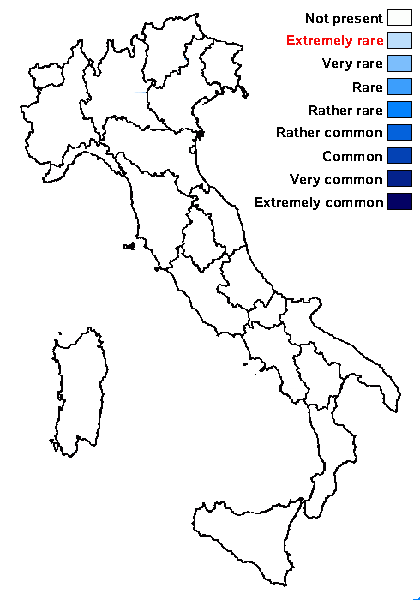Athallia brachyspora (Mereschk.) Halıcı & Vondrák
in Vondrák & al., Turkish J. Bot., 40: 322, 2016. Basionym: Caloplaca brachyspora Mereschk. - Lich. Flor. Ross. Occid. Exsicc.: no. 22, 1913
Synonyms:
Distribution:
Description: Thallus crustose, endosubstratic or thinly episubstratic, inapparent or pale to dark grey, without a distinct prothallus. Apothecia zeorine, sessile, c. 0.5-0.7 mm across, with a mostly flat, orange disc and a paler, yellow-orange margin. Epithecium orange-brown, K+ red; hymenium colourless c. 70 µm high; paraphyses sparingly branched in upper part, the apical cells often swollen; hypothecium colourless. Asci 8-spored, cylindrical-clavate, functionally unitunicate, apically thickened with a broad internal beak, the inner part of apex and external cap I+ blue, Teloschistes-type. Ascospores 2-celled, polarilocular, hyaline, broadly ellipsoid, 7.3-11 x 5-6.5(-7.5) µm, the equatorial thickening (“septum”) 2.2-3 µm (c. 1/4 of spore length). Photobiont chlorococcoid. Spot tests: thallus K-, C-, KC-, P-; apothecia K+ red. Chemistry: thallus without lichen substances; apothecia with parietin (major), fallacinal, emodin, teloschistin and parietinic acid (minor), corresponding with chemosyndrome A of Søchting (1997).Note: a long-forgotten calcicolous species of exposed sites, described from Crimea and recently found also in the Carpathians, where it is common (Maliček & al. 2014), and in the Alps (Austria and Switzerland, Palice & al. 2018), where it is probably much more widespread, but was previously confused with other species, especially Variospora macrocarpa. To be looked for in Italy.
Growth form: Crustose
Substrata: rocks
Photobiont: green algae other than Trentepohlia
Reproductive strategy: mainly sexual

Predictive model
Growth form: Crustose
Substrata: rocks
Photobiont: green algae other than Trentepohlia
Reproductive strategy: mainly sexual

Predictive model


